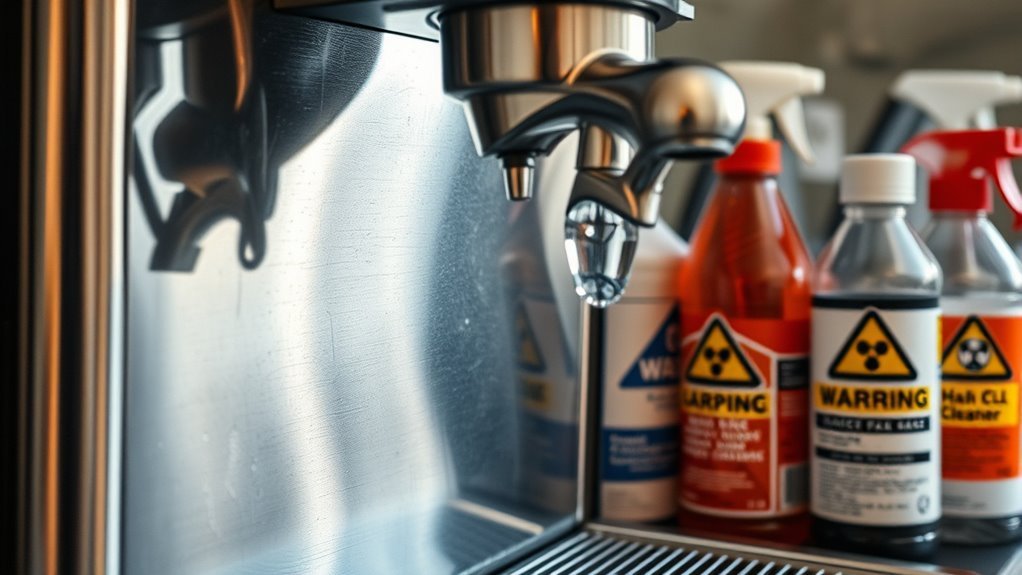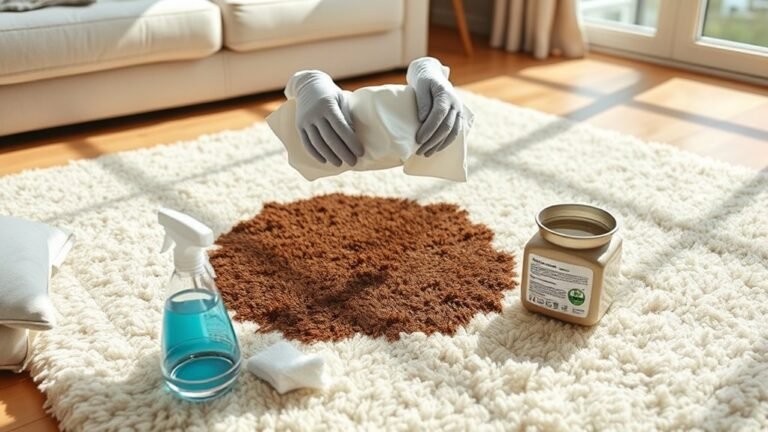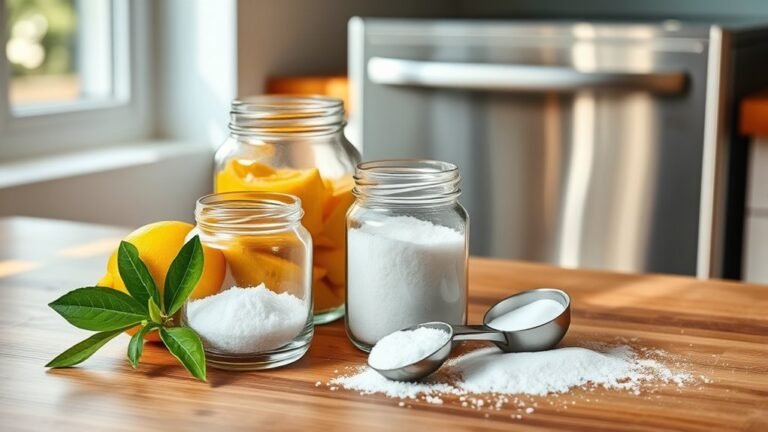Cleaning Mistakes That Damage Your Coffee Machine
If you use harsh chemicals or vinegar without diluting it properly, you’re risking damage to seals and internal parts of your coffee machine. Submerging the whole machine in water or scrubbing delicate components too hard can ruin electronics and cause cracks. Skipping regular descaling, ignoring the water reservoir, and neglecting drip tray cleaning can also harm your machine and affect coffee flavor. Keep your machine safe and your coffee tasty—you’ll find even more handy tips ahead.
Using Harsh Chemicals Instead of Recommended Cleaners

Although it might seem like a quick fix, using harsh chemicals instead of the recommended cleaners can damage your coffee machine’s internal components. You want the freedom to enjoy great coffee without worrying about costly repairs caused by corrosive substances. Harsh chemicals might offer strong cleaner effectiveness on the surface, but they often compromise chemical safety, eroding seals and delicate parts inside your machine. Choosing the right cleaner guarantees thorough cleaning while protecting your machine’s longevity. Sticking to recommended products means you’re not just maintaining your coffee maker but also preserving the freedom to brew worry-free. Don’t sacrifice your machine’s health for a quick clean; prioritize chemical safety and effective cleaners to keep your coffee flowing smoothly and your freedom intact.
Ignoring Regular Descaling Procedures
If you skip regular descaling, your coffee machine can quickly build up mineral deposits that affect taste and performance. Ignoring this crucial step not only dulls the flavor of your brew but also strains the machine’s internal components, cutting its lifespan short. Understanding the descaling importance means recognizing that mineral buildup can clog pipes and reduce water flow. You want your coffee machine to work smoothly, right? Regular maintenance, including descaling, keeps it running freely and preserves the quality you cherish. Don’t let neglect limit your coffee freedom. By sticking to a descaling schedule, you guarantee every cup tastes just right, and your machine stays in top shape. Freedom in flavor starts with freedom from buildup, so make descaling a regular part of your routine.
Submerging the Entire Machine in Water

One common mistake people make is submerging their entire coffee machine in water, which can cause serious damage. Machine immersion often leads to water damage, ruining electrical components and voiding warranties. Instead, clean only removable parts that the manufacturer specifies.
| Component | Cleaning Method |
|---|---|
| Removable Drip Tray | Rinse under running water |
| Water Reservoir | Wipe with a damp cloth |
| Electrical Parts | Never immerse in water |
Avoiding full submersion guarantees your machine’s longevity and functionality. When you clean correctly, you maintain freedom to enjoy fresh coffee without costly repairs. Remember, water damage from improper cleaning restricts your machine’s lifespan, so handle it with care and follow manufacturer instructions closely.
Over-Scrubbing Delicate Components
When you clean your coffee machine, scrubbing too hard on delicate components can cause more harm than good. These parts, like the filter basket or the water reservoir lid, are designed to be handled gently. Using aggressive cleaning techniques might lead to cracks, scratches, or malfunction. Instead, opt for soft cloths or gentle brushes with mild detergent to keep them safe. Remember, preserving the integrity of delicate components guarantees your machine stays reliable and delivers great coffee. By mastering careful cleaning techniques, you’ll avoid unnecessary damage and enjoy the freedom to maintain your machine without worry. Taking a light touch not only protects your investment but also makes your cleaning routine smoother and more effective over time.
Using Abrasive Cleaning Pads or Brushes

You might think abrasive pads or brushes will get your coffee machine spotless, but they can actually cause surface scratches and damage protective coatings. Once scratched, those surfaces become more prone to residue buildup and harder to clean over time. It’s best to choose gentler tools to keep your machine in top shape.
Surface Scratches Risk
Scratches on your coffee machine’s surface can quickly dull its appearance and even affect its functionality. When you use abrasive cleaning pads or brushes, you risk damaging the delicate finish, undermining surface protection. It’s tempting to scrub hard, but this only leads to unsightly marks that are tough to fix. To keep your machine looking sharp and performing well, focus on scratch prevention by choosing gentle cleaning tools like soft cloths or non-abrasive sponges. These protect the surface while effectively removing dirt and oils. Remember, preserving the machine’s exterior isn’t just about aesthetics—it maintains its value and guarantees it lasts longer. So, ditch harsh scrubbing and embrace safer cleaning methods that honor your coffee machine’s design and your freedom to enjoy every cup.
Protective Coating Damage
Although abrasive cleaning pads or brushes might seem effective for tackling stubborn stains, they can severely damage your coffee machine’s protective coating. Ignoring protective coating care can lead to scratches that expose the metal beneath, causing corrosion and reducing your machine’s lifespan. To keep your coffee maker in top shape, follow these maintenance tips:
- Always use a soft cloth or sponge when cleaning surfaces.
- Choose gentle, non-abrasive cleaning agents designed for delicate finishes.
- Avoid scrubbing vigorously; let cleaners soak if needed to loosen grime.
Residue Buildup Issues
When abrasive cleaning pads or brushes are used on your coffee machine, they can leave behind tiny grooves that trap coffee oils and residue. These grooves amplify residue effects, causing unpleasant flavors and even bacterial growth over time. You want your machine to deliver freedom from stale tastes, not be held hostage by buildup. Instead of harsh tools, opt for soft cloths or brushes designed for delicate surfaces. Adjust your cleaning frequency to prevent stubborn residue from taking hold—regular gentle cleaning keeps your machine running smoothly without damage. Remember, the goal is to maintain your coffee machine’s integrity while enjoying fresh, flavorful brews every day. Avoid abrasive tools, clean often but gently, and you’ll enjoy a machine that serves you well without the residue setbacks.
Neglecting to Clean the Coffee Grounds Container
If you don’t regularly clean the coffee grounds container, old grounds can build up and cause unpleasant odors or mold growth. This not only affects your coffee’s taste but also risks your health. Keeping this container clean brings key benefits of cleanliness and supports your coffee machine longevity. Here’s why you shouldn’t neglect it:
- Prevents mold and bacteria, ensuring each cup tastes fresh and pure.
- Avoids clogging, which can lead to costly repairs or reduced machine efficiency.
- Maintains freedom from foul smells, letting you enjoy coffee without distractions.
Treat your coffee grounds container with care, and your machine will reward you with consistent, delicious brews and a longer lifespan. Don’t let neglect limit your coffee experience!
Failing to Clean the Water Reservoir Frequently
If you don’t clean your water reservoir often, mineral buildup can clog your machine and affect its performance. You also risk mold growth, which isn’t safe and can spoil the taste of your coffee. Keeping the reservoir clean guarantees every cup tastes fresh and your machine runs smoothly.
Mineral Buildup Risks
Although it might seem harmless to skip cleaning your coffee machine’s water reservoir regularly, doing so can lead to serious mineral buildup. This buildup clogs your machine, affecting both performance and taste. To keep your coffee machine running smoothly and enjoy freedom from annoying clogs, focus on mineral buildup prevention with these tips:
- Clean the reservoir weekly: Empty and rinse it out to prevent scale from settling.
- Use filtered water: This reduces minerals entering your machine, easing coffee machine maintenance.
- Descale monthly: Use a descaling solution to break down any mineral deposits.
Following these simple steps keeps your coffee machine in top shape, ensuring every cup tastes fresh and your machine lasts longer. Don’t let mineral buildup steal your coffee freedom!
Mold Growth Hazards
When you don’t clean your coffee machine’s water reservoir regularly, mold can quickly take hold, creating health risks and unpleasant odors. Ignoring this vital step compromises your freedom to enjoy a fresh, safe brew. Mold thrives in stagnant water and warm environments, so staying on top of cleaning frequency importance is key. Using simple mold prevention techniques, like rinsing and drying the reservoir every few days, stops mold before it starts. Don’t let neglect limit your coffee experience or expose you to harmful spores. By committing to a regular cleaning schedule, you keep your machine fresh and extend its life. Remember, a clean reservoir isn’t just about hygiene—it’s about reclaiming control over your daily ritual without unwanted risks.
Impact on Taste
Neglecting to clean your coffee machine’s water reservoir regularly can seriously affect the taste of your brew. When you skip this essential step, you risk compromising the flavor balance and ignoring your unique taste preferences. Here’s why cleaning matters:
- Stale water buildup can cause off-flavors, dulling the coffee’s natural brightness and aroma.
- Mineral deposits alter water quality, disrupting the delicate flavor balance you aim for.
- Residue and bacteria growth lead to sour or bitter notes, ruining your perfect cup.
Skipping the Cleaning of the Drip Tray
Even if the drip tray seems like a minor part of your coffee machine, skipping its cleaning can lead to unpleasant odors and mold buildup. The drip tray importance is often underestimated, but it catches excess water and coffee drips, preventing messes and bacterial growth. Ignoring its maintenance not only affects cleanliness but can also impact your machine’s performance and your coffee’s flavor. To keep your coffee machine running smoothly and your space fresh, you should clean the drip tray regularly—ideally every time you empty it or at least once a week. By sticking to this cleaning frequency, you free yourself from unwanted smells and potential health risks, ensuring your coffee ritual stays enjoyable and your machine lasts longer.
Using Vinegar as a Descaling Agent Improperly
Keeping every part of your coffee machine clean, from the drip tray to internal components, is key to maintaining its performance. When using vinegar as a descaling agent, you need to be cautious to avoid damaging your machine.
- Vinegar concentration: Don’t use undiluted vinegar; a 1:1 or 1:2 ratio with water is usually best. Too strong vinegar can corrode internal parts.
- Descaling frequency: Overdoing it stresses your machine. Stick to the recommended interval—usually every 1-3 months, depending on your water hardness.
- Rinse thoroughly: After descaling, run multiple water cycles to flush out vinegar residues, preventing taste issues and corrosion.
Not Following Manufacturer’s Cleaning Instructions
You might be tempted to skip your coffee machine’s cleaning instructions, but that can lead to problems. Using the wrong products or cleaning too often—or not enough—can damage your machine. Sticking to the manufacturer’s guidelines helps keep your coffee tasting great and your machine running smoothly.
Ignoring Specific Cleaning Guidelines
Although it might seem easier to skip the manual, not following your coffee machine’s specific cleaning instructions can cause serious problems. Ignoring specific guidelines often leads to damage, reduced performance, and costly repairs. You want your machine running smoothly, right? Stick to these maintenance tips to keep freedom in your daily brew:
- Follow the manufacturer’s recommended cleaning schedule to avoid buildup and malfunction.
- Use the exact cleaning methods described to protect sensitive parts and avoid voiding warranties.
- Pay attention to water hardness and descaling instructions tailored for your model.
Using Incorrect Cleaning Products
Once you’ve committed to following your coffee machine’s cleaning schedule, the next step is making certain you use the right products. Using incorrect product usage can cause more harm than good. Many cleaners contain harsh chemicals that might seem effective but can actually damage seals, filters, and internal components over time. These harmful ingredient effects aren’t always obvious at first but can shorten your machine’s lifespan and affect the taste of your coffee. Sticking to the manufacturer’s recommended cleaning products guarantees you’re protecting your investment and maintaining the freedom to enjoy perfect brews without worry. Don’t let shortcuts or off-brand cleaners compromise your machine’s performance—choose wisely, follow instructions, and keep your coffee routine hassle-free and reliable.
Overlooking Recommended Cleaning Frequency
Frequently ignoring the recommended cleaning schedule can quickly lead to buildup that affects both the taste of your coffee and the machine’s performance. Skipping or delaying cleaning means oils and minerals accumulate, causing blockages and off-flavors. To keep your coffee machine running smoothly and preserve that fresh brew, stick to the manufacturer’s maintenance reminders. Here’s how to stay on track:
- Set clear cleaning schedule alerts on your phone or calendar.
- Follow the exact cleaning steps recommended for your model—don’t improvise.
- Don’t ignore warning lights or messages from your machine; they’re there for a reason.
Frequently Asked Questions
How Often Should I Replace the Water Filter in My Coffee Machine?
You should replace your coffee machine’s water filter based on its water filter lifespan, which is usually every two to three months. Sticking to this replacement frequency helps keep your coffee tasting fresh and your machine running smoothly. Of course, if you use hard water or brew often, you might need to swap it out sooner. Keeping up with this frees you from worrying about build-up or off-flavors, letting you enjoy every cup.
Can I Use Bottled Water Instead of Tap Water to Reduce Buildup?
You absolutely can use bottled water to reduce buildup in your coffee machine. Bottled water benefits you by offering consistent water quality impact, which helps prevent mineral deposits that often come from hard tap water. This means your machine stays cleaner longer, and your coffee tastes better. Choosing bottled water gives you more control and freedom over what goes into your brew, so you’re not stuck dealing with unpredictable tap water issues.
What Is the Best Way to Clean the Coffee Machine’S Steam Wand?
To keep your steam wand in top shape, you want to use effective cleaning techniques. Right after steaming milk, wipe the wand with a damp cloth to remove residue. Then, purge it by releasing steam for a few seconds to clear any buildup inside. For a deeper clean, soak the tip in a solution made for espresso machines or use a specialized brush. These steps help you enjoy smooth, flavorful drinks without hassle.
Are There Specific Brands of Coffee Machines That Require Special Cleaning Methods?
Like a tailor-made suit, each coffee machine brand has its own fit when it comes to cleaning. You’ll want to check brand specifications closely because cleaning techniques can vary widely. Some machines need special descaling solutions or delicate handling of parts to keep them running smoothly. Don’t just wing it—following the brand’s recommended methods lets you keep your coffee flowing freely without risking damage or voiding warranties.
How Can I Tell if My Coffee Machine Needs Professional Servicing?
You’ll know your coffee machine needs professional servicing if you notice a drop in coffee quality, like bitter taste or weak brew. Other maintenance signs include unusual noises, leaks, or slow brewing. If you want to keep enjoying freedom in your coffee routine without interruptions, don’t ignore these signals. Getting a pro to check it out can save you time and hassle, letting you savor every cup without worries.






